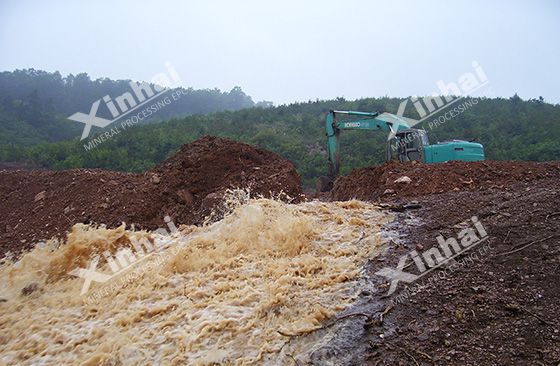
Fluorite is an important non-metallic mineral resource and the main source of fluorine in the industry. It is widely used in metallurgy, aluminum smelting, glass, ceramics, cement, chemical industry and other fields.
There are three kinds of processing processes of fluorite: hand separation, gravity separation and flotation separation. Among them, hand separation and gravity separation are mostly used as auxiliary separation and pre-separation, while flotation separation is the main method. According to different associated minerals, fluorite ores can be divided into quartz-type fluorite ore, calcite-type fluorite ore, barite-type fluorite ore and polymetallic symbiosis type fluorite ore, etc. The flotation processes of each mineral are different with different properties.
Quartz-type fluorite ore is mainly composed of fluorite (content 80%-90%) and quartz, accompanied by a small amount of calcite, barite, pyrite and kaolinite and other minerals.
For the flotation of this type of fluorite ore, fatty acids are often used as collectors, sodium carbonate is used as a slurry pH adjuster (pH value is 8-9), and water glass is used as an inhibitor. The high-quality fluorite concentrate can be obtained after several selections.

It is worth noting that the quartz-type fluorite ore is divided into coarse-grained fluorite ore and fine-grained fluorite ore according to the embedding characteristics of useful minerals. In the above flotation method, fine-grained embedded fluorspar ore has increased flotation difficulty due to its finer particle size, so it is necessary to strengthen the grinding operation to improve the monomeric dissociation of the target minerals.
Calcite-type fluorite ore is dominated by fluorite, and co-associated ores include calcite (30% or more) and a small amount of quartz, sometimes in the form of quartz-calcite-fluorite ore.
Since fluorite and calcite are both calcium-containing salt minerals with similar solubility, both have strong adsorption operation when fatty acids are used as the collector. Therefore, it usually adopts inhibitors of calcium-containing minerals (such as water glass, sodium metaphosphate, lignin sulfonate, dextrin, tannic acid, oxalic acid), oleic acid as the collector, and sodium carbonate as the pH regulator (pH value of 8~9.5) to separate by bulk flotation first, and then conduct the fluorite and calcite flotation separation. In order to improve the inhibition effect, the reagents are mostly added to the flotation slurry in the combined form.

Barite-type fluorite ore is dominated by barite (content 10%-40%) and fluorite ore, with a small amount of associated pyrite, galena, sphalerite, etc. Some deposits contain a large amount of quartz, which exists in the form of barite-fluorite-quartz ore.
The flotation of this type of ore generally uses oleic acid as the collector, and water glass as the inhibitor. It processes the bulk concentrate of barite and fluorite first, followed by the separation of fluorite and barite.
There are two methods to separate fluorite and barite. One is to inhibit barite and separate fluorite by flotation, the other is to inhibit fluorite and separate barite by flotation.

(1) Inhibit barite and separate fluorite by flotation
After obtaining the bulk concentrate of barite and fluorite, aluminum sulfate, water glass and tannin extract are used as a combined inhibitor of barite, and the fluorite and barite are separated by one roughing and several flotation processes. This method obtains a higher grade of barite concentrate, but a relatively low grade of fluorite.
(2) Inhibit fluorite and separate barite by flotation
After obtaining the bulk concentrate of barite and fluorite, it uses barium chloride to activate barite, sodium hydroxide and sodium silicate to inhibit fluorite to separate barite preferentially. Then it uses oleic acid as the collector, sodium silicate and aluminum sulfate as inhibitors to separate fluorite from tailings. This process obtains a high grade of fluorite ore concentrate, but the grade of barite is relatively low.
Polymetallic symbiosis type fluorite ore are mainly quartz and fluorite, and accompanied by more heavy metal minerals, such as galena, sphalerite, chalcopyrite, pyrite and scheelite, etc.
For this type of fluorite ore, the priority flotation separation is generally used to separate useful minerals in sequence. The metal sulfide minerals are preferentially separated with sulfide mineral collectors (xanthate, aerofloat, etc.), and then it uses fatty acid as the collector (oleic acid, oxidized paraffin soap, etc.) to separate fluorite ore from metal sulfide tailings.
.jpg)
The above are the flotation processes for different types of fluorite ore. For different properties of fluorite ore, different processes have a greater impact on the concentrate index. As for which flotation process to choose, it is necessary to determine the associated minerals in the fluorite ore through processing tests to choose a reasonable process.
To find out more about our products and solutions, please fill out the form below and one of our experts will get back to you shortly.